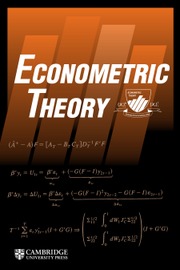Article contents
STRUCTURAL CHANGE TESTS BASED ON IMPLIED PROBABILITIES FOR GEL CRITERIA
Published online by Cambridge University Press: 21 May 2012
Abstract
This paper proposes Pearson-type statistics based on implied probabilities to detect structural change. The class of generalized empirical likelihood estimators (see Smith 1997, The Economic Journal107, 503–519) assigns a set of implied probabilities to each observation such that moment conditions are satisfied. The proposed test statistics for structural change are based on the information content in these implied probabilities. We consider cases of structural change with unknown breakpoint that can occur in the parameters of interest or in the overidentifying restrictions used to estimate these parameters. We also propose a structural change test based on implied probabilities that is robust to weak identification or cases in which parameters are completely unidentified. The test statistics considered here have competitive size and power properties. Moreover, they are computed in a single step, which eliminates the need to compute the weighting matrix required for generalized method of moments estimation.
Information
- Type
- Articles
- Information
- Copyright
- Copyright © Cambridge University Press 2012
References
REFERENCES
- 3
- Cited by

